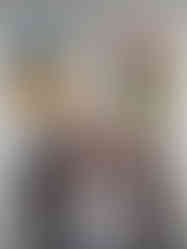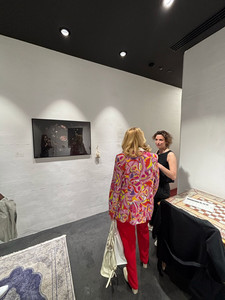Opening Night - 250 Rue de Rivoli
- martinamargaux
- Apr 30
- 5 min read
Updated: May 3
Yesterday was the opening of a new exhibition I’m part of, with other two brilliant female artist, Daniella McNulty and Anum Sajjad.
It was a beautiful warm evening, the sun gently bathing Rue de Rivoli, in the centre of Paris.
Last month I had my first exhibition in Paris in a bar. I loved it. It was fun, busy, beautifully messy. This time, the atmosphere was more calm, intimate, (and clean!).
My work is installed in a separate room from the main space, a bit hidden. At first I worried people would mostly hang out in the sun and I wouldn’t get many visitors. I was wrong. A lot of people came! And the separate space actually turned out to be a great setting to talk about the work, away from the buzz of the main space in the boutique.
It was wonderful to see friends and long time supporters show up for me. But also a lot of strangers visited the exhibition and asked me loads of questions about the work.
I am quite happy of how I managed the flow of people and presentation of my work this time. I guess my Creative Director skills kicked in under pressure and proved very useful in this context.
I don’t even know how I did it. I began explaining the work to the first group of visitors and found the words came naturally. Everything felt clear and focused in my mind.
I gave one-on-one presentations as well as explanations to larger groups. And as the evening went on, I realised I was somehow repeating almost exactly the same thing over and over, switching from French to English to Italian, adapting it to the audience if I felt they were more interested by the emotional, intellectual or technical aspect of the work. No script. No rehearsal. Just presence. Man, I do work well under pressure.
I’ll try to record here the main points of the speech:
“Thank you so much for coming.
You are looking at photographs, but to make these images I don’t use a camera. It goes down to the basics of photography, literally “drawing with light”.
For those of you who are not familiar with it, let me explain. To make a photograph, you employ a sheet of silver gelatin paper. The paper is coated with a photo-sensitive emulsion. Light exposure triggers a chemical reaction, and when you develop it, an image emerges.
Normally, with “traditional” darkroom methods, you would place a negative into the enlarger, which filters the amount of light and gives form to the image you took with a camera.
In my case, there’s no camera, no lens, no negative, and no enlarger. But from the basic elements of photography, light and paper, I pushed a step further.
I'm interested in the connections between the mind, the materials, and the perception of spiritual and invisible realities. So I introduced to my practice a ritual material that connects all of us, through cultures and through time: incense.
Watch out, incense is not just the scented sticks you find burning in fancy massage parlours in the Western part of the World.
Incense by definition is “anything that burns” (and smells good!). It can have different forms - it can be scented woods, resins of vegetal or animal origin, powders, sticks… And for millennia, we have burnt this material in rituals to connect with the gods, with the immortal, with the invisible, with the inexplicable, with elsewhere.
So, in the darkroom, I created my own personal ritual, in which I burn incense directly onto the photosensitive paper. The emulsion reacts to the heat and the light of combustion, and reveals images of places and creatures from elsewhere.
Then I scan the original photograph, which is much smaller that the prints on show, and produce these fine art prints. I only make minor digital adjustments - simply a balance of contrast and minimal clean up (all my works have dog hair floating around somewhere!). So the colours and shapes you see are absolutely authentic.
The pouches you see next to the artworks are filled with incense. An attempt to communicate the sensory aspect of this process. When I am making the images, I am physically engaged with these materials - their scent, their textures… I literally breath them in. You are invited to touch them and smell them and think about the transformation they went through to become the images you see here.
Some see cosmic landscapes, some unicellular micro-organisms…others everything in between. I don’t even know what they are, but through this ritual process, they exist. They become manifest. They emerge from literally nothing.
Through the destruction of the material, creation is enabled. Transformation.
In this sense, who is the author of the work? Is it me? Is it the incense? Is it something other?
I see myself more like a medium in this process, a facilitator. I can’t take full credit. Maybe I can share it…
The ritual that takes place in the darkroom, my sanctuary, is recorded in these images. They are traces of the fleeting dialogue between me and the material. They are portals to somewhere else, somewhere other maybe.
I hope you enjoy, let me know if you have any questions. Thank you”
People seemed to understand and be genuinely engaged. Many asked questions about the technical aspects, wrapping their head around how this is possible. That’s the alchemical and magical part of the practice…
I was surprised by how many people (of all ages) today don’t know how analogue photography works. That was me less than two years ago! And I am so proud and even surprised by how much I have learnt about it in this time.

At the end of the night, when I got back home, I noticed a message request on Instagram from someone I don’t know. From the profile picture, I recognised a man who had been part of a group I spoke to earlier in the evening.
It said: “Bonsoir Martina. J’ai été enchanté de découvrir tes magifiques œuvres ce soir, et de faire ta connaissance”
(ENG: "Good evening, Martina. I was really delighted to discover your magnificent work this evening and to have the chance to meet you.")
Long ago in class, I said that I believed that if a work can move even just one person, it can be considered professional art. Well, it feels like that moment has come for me. It couldn’t have had better timing, and it might not have come at all without the support this course gave me. Thank you.

































Comments